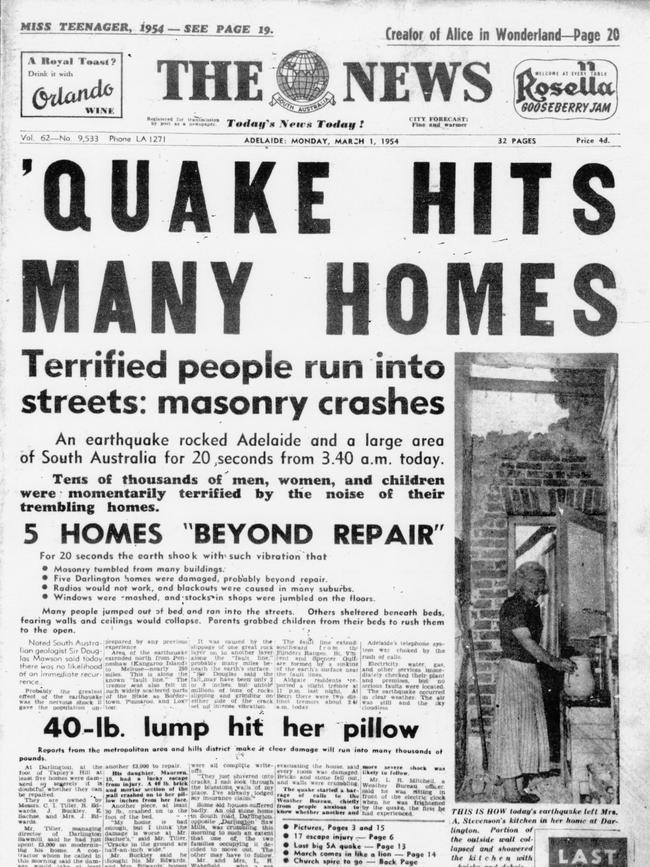Adelaide risks earthquake bigger than Christchurch NZ (2011): Geoscience Australia
After a magnitude 7.8 earthquake rocked Turkey on Monday, scientists say Adelaide could also experience a powerful quake. See if you’re living near a fault line.
SA News
Don't miss out on the headlines from SA News. Followed categories will be added to My News.
Adelaide could experience an earthquake 30 times more powerful than the one that hit Christchurch, New Zealand, in 2011, Geoscience Australia says.
By digging trenches along the Willunga fault line, geologist Dr Dan Clark uncovered new evidence of large earthquakes in our distant past.
“We calculate that the 55km active length of this fault could potentially host an earthquake as large as magnitude 7.2,” he said.
“An earthquake of this size would involve approximately 30 times the energy released by the earthquake that devastated Christchurch.”
The Willunga fault line snakes its way from the southern Adelaide Hills, west of the Mt Bold Reservoir, down through Willunga and out to Sellicks Beach.
Adelaide is considered one of Australia’s most seismically active areas, straddling several faults.
These include the Para Fault, which runs from around Gawler, under Adelaide’s northern suburbs, under the CBD and out towards Glenelg, and the Eden-Burnside Fault under the eastern and southern suburbs.
There have been 10 earthquakes larger than magnitude 3.0 within 150km of Adelaide in the past decade. The largest of these was the 3.7 magnitude earthquake at Mt Barker in March.
The likelihood of Adelaide experiencing a large earthquake will be further refined as the study progresses and past events are dated.

But Dr Clark estimated that a magnitude 7.2 earthquake “might occur once every few tens of thousands of years but, similar to floods, earthquakes that are smaller in magnitude will be more frequent”.
“A magnitude 6.2 of the size of the Christchurch earthquake, for instance, might happen every thousand years or every few thousand years. And earthquakes the size of the 1954 Adelaide earthquake might happen every few hundred years or every 100 years.”
Scientists from Geoscience Australia, alongside researchers and students from the University of Melbourne and the Seismology Research Centre, excavated two large trenches to expose the Willunga fault 40km south of Adelaide.
They searched for layers of sediment that had been displaced by an earthquake and these layers will now be dated to estimate when each earthquake occurred.

The study findings will be used to update Geoscience Australia’s National Seismic Hazard Assessment, which describes the likelihood of strong ground shaking due to earthquakes to enable communities to be better prepared.
“It's important that if an average person finds themselves in an earthquake, they have a bit of an idea what to do; drop, cover and hold,” Dr Clark said.
That means drop to the ground; cover your head and neck; ideally get under something solid, such as a table; and hold on tight.
Dr Clark said the latest research was “definitely an advance on what we knew before” and was based on overseas studies on more earthquake-prone areas such as Tokyo.
“We haven't seen in most places in Australia the largest earthquakes that can be generated,” he said.
“Critical infrastructure, facilities and the community in general should be prepared for these events, even if they are very infrequent.”
While he did not expect residential builders to respond to the new information straight away, Dr Clark said any manager of a dam, power station or hospital would be very interested.


FAST FACTS FROM GEOSCIENCE AUSTRALIA:
Earthquakes in Australia are caused by the slow build-up of stress in the interior of the continent, produced as the Australian tectonic plate moves approximately 7cm to the northeast every year. The stress that builds in these tectonic plates during this movement is released as an earthquake.
The National Earthquake Alerts Centre at Geoscience Australia provides rapid alerts of significant earthquakes occurring in Australia and overseas, including earthquakes with potential to cause a tsunami, 24 hours a day, 365 days a year.
There have been 10 earthquakes larger than magnitude 3.0 within 150km of Adelaide in the past 10 years. The largest in the past decade was the 3.7 magnitude earthquake which occurred at Mt Barker in March this year. More than 12,000 felt reports were lodged after this event.
On average, Australia experiences an earthquake above magnitude 5.0 once every one to two years. An earthquake above magnitude 6.0 occurs approximately once every 10 years. Australia's largest recorded earthquake was in 1988 at Tennant Creek in the Northern Territory, with an estimated magnitude of 6.6.
On 1 March, 1954, Adelaide had a magnitude 5.4 earthquake. It resulted in three serious injuries and damage to 3000 buildings. More than 30,000 insurance claims were filed for damage such as collapsed and cracked walls, smashed windows and collapsed chimneys. Damage to Adelaide also occurred in the magnitude 6.0 Warooka earthquake on 19 September, 1902.




